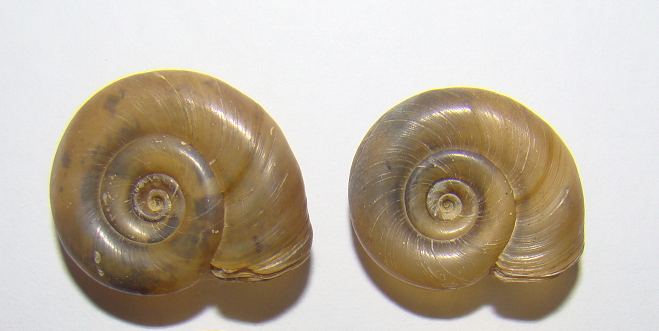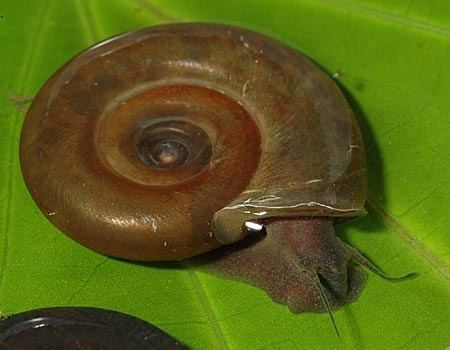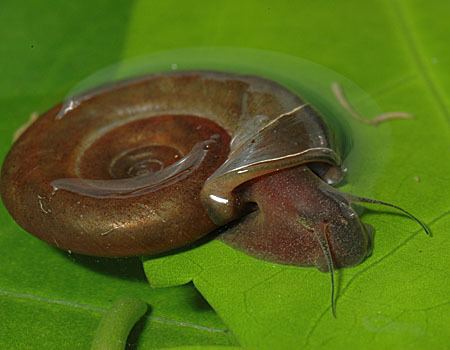Tribe Biomphalariini Higher classification Planorbidae Rank Genus | Superfamily Planorboidea Subfamily Planorbinae Scientific name Biomphalaria | |
 | ||
Lower classifications Biomphalaria glabrata, Biomphalaria tenagophila, Biomphalaria straminea, Biomphalaria pfeifferi, Biomphalaria havanensis | ||
How schistosoma mansoni miracidia react to the raw mucus of biomphalaria glabrata
Biomphalaria is a genus of air-breathing freshwater snails, aquatic pulmonate gastropod mollusks in the family Planorbidae, the ram's horn snails and their allies.
Contents
- How schistosoma mansoni miracidia react to the raw mucus of biomphalaria glabrata
- Schistosoma mansoni miracidia attracts to the hplc fraction of biomphalaria glabrata scw
- Species
- Distribution
- Parasites
- References

Biomphalaria is the type genus of the tribe Biomphalariini.
Taphius is a synonym for Biomphalaria.
The shell of this species, like all planorbids is sinistral in coiling, but is carried upside down and thus appears to be dextral.

Schistosoma mansoni miracidia attracts to the hplc fraction of biomphalaria glabrata scw
Species
There are 34 species in the genus Biomphalaria in total.
There are 22 American species:

- Biomphalaria amazonica Paraense, 1966
- Biomphalaria andecola (d'Orbigny, 1835)
- Biomphalaria cousini
- Biomphalaria edisoni Estrada, Velásquez, Caldeira, Bejarano, Rojas & Carvalho, 2006
- Biomphalaria glabrata (Say, 1818)
- Biomphalaria havanensis (L. Pfeiffer, 1839)
- Biomphalaria helophila (d'Orbigny, 1835)
- Biomphalaria intermedia (Paraense & Deslandes, 1962)
- Biomphalaria kuhniana (Clessin, 1883)
- Biomphalaria obstructa
- Biomphalaria occidentalis Paraense, 1981
- Biomphalaria oligoza Paraense, 1974
- Biomphalaria orbignyi Paraense, 1975
- Biomphalaria peregrina (d'Orbigny, 1835)
- Biomphalaria prona
- Biomphalaria schrammi (Crosse, 1864)
- Biomphalaria straminea (Dunker, 1848)
- Biomphalaria subprona (Martens, 1899) - [1]
- Biomphalaria temascalensis Rangel-Ruiz, 1987
- Biomphalaria tenagophila (d'Orbigny, 1835)
There are 12 species in the Old World (Africa, Madagascar and the Middle East):

- Biomphalaria alexandrina
- Biomphalaria angulosa Mandahl-Barth, 1957
- Biomphalaria barthi Brown, 1973
- Biomphalaria camerunensis
- Biomphalaria choanomphala
- Biomphalaria pfeifferi (Krauss, 1848)
- Biomphalaria salinarum Morelet
- Biomphalaria smithi Preston, 1910 - type species
- Biomphalaria stanleyi (Smith, 1888)
- Biomphalaria sudanica (Martens, 1870)
- Biomphalaria tchadiensis Germain, 1904
- Biomphalaria ruppellii Auet. - subspecies: Biomphalaria ruppellii ruppellii Auet.; Biomphalaria ruppellii katangae Haas
There is one known hybrid Biomphalaria glabrata × Biomphalaria alexandrina from Egypt.
A cladogram showing phylogenic relations of (23 analyzed) species in the genus Biomphalaria:
Distribution

The origin of the genus Biomphalaria is American. The ancestor of Biomphalaria glabrata colonized Africa 2.3–4.5 or 2-5 millions years ago and speciated into all the African Biomphalaria species.
Natural populations of these snails are usually found in tropical standing water or freshwater in South America and Africa, but they also reach 30° latitude in subtropical areas. Many species of these red-blooded planorbid snails (Gastropoda: Basommatophora) are able to survive a long time when removed from their freshwater habitat. Of the 34 Biomphalaria species, 4 (Biomphalaria glabrata, Biomphalaria pfeifferi, Biomphalaria straminea, and Biomphalaria tenagophila) have recently expanded their native ranges. They have been introduced to areas where other Biomphalaria species are endemic (e.g., Congo and Egypt) or to subtropical zones that have no frost period (Texas, Louisiana, Florida, Hong Kong).
All species in the genus Biomphalaria except of native Biomphalaria obstructa has not yet become established in the USA, but they are considered to represent a potentially serious threat as a pest, an invasive species which could negatively affect agriculture, natural ecosystems, human health or commerce. Therefore, it has been suggested that this species be given top national quarantine significance in the USA.
Parasites
This genus of snails is medically important, because the snails can carry a parasite of humans which represents a serious disease risk: the snails serve as an intermediate host (vector) for the human parasitic blood fluke, Schistosoma mansoni, that infects about 83 million people.
The human disease schistosomiasis (aka snail fever) caused by all Schistosoma species (transmitted also by other snails) infects 200 million people. The fluke, which is found primarily in tropical areas, infects mammals (including humans) via contact with water that contains schistosome larvae (cercariae) which have previously been released from the snail. Infection occurs via penetration of cercariae through the skin.
Eighteen species of Biomphalaria are intermediate hosts for Schistosoma mansoni; seven species of the genus have not been tested for this susceptibility and nine species are resistant.
Altogether about 30 species of parasites from Africa and at least 20 species from the Neotropics are known to parasitize Biomphalaria.
